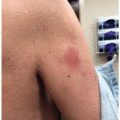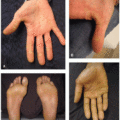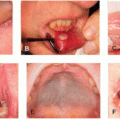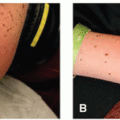Anthracyclines
Emma H. Weiss
Caroline A. Nelson
Jonathan S. Leventhal
Anthracycline antibiotics are derived from Streptomyces species and are a commonly used cytotoxic treatment for both solid and hematologic malignancies (Table 25.1). Anthracyclines demonstrate antitumor effects through disruption of topoisomerase-II-mediated DNA repair and oxidative stress to cellular membranes, DNA, and proteins. Pegylated liposomal doxorubicin (PLD) consists of a liposomal covering with polyethylene glycol segments which impede the mononuclear phagocyte system, conferring advantages in drug delivery and a slightly different side effect profile.1
Common cutaneous adverse events include alopecia, nail changes, toxic erythema of chemotherapy (TEC)/hand-foot syndrome (HFS), drug-induced hyperpigmentation, and radiation recall dermatitis.
Chemotherapy-induced alopecia (CIA) is common, reported in 80% to 100% of patients treated with topoisomerase inhibitors.2 CIA is highly variable, influenced by treatment dose and schedule, concomitant use of additional cytotoxic chemotherapies, and individual patient characteristics.3 Anthracyclines target the rapidly dividing matrix keratinocytes of anagen hair shafts and lead to patchy or diffuse anagen effluvium within weeks of starting treatment, progressing to complete nonscarring alopecia within 2 to 3 months.4 Less commonly, anthracyclines can lead to persistent chemotherapy-induced alopecia, characterized by lack of regrowth by 6 months post-treatment. Other characteristics such as permanent hair texture, color, and quality changes have also been reported.
Several nail changes have been associated with anthracyclines (Table 25.2). Direct cytotoxic effects on the nail matrix lead to brittle nails, slowed nail growth, painful onycholysis and subungual hemorrhage (Figure 25.1). There can also be associated periungual erythema and edema. Disruption of the nail unit may predispose to secondary infections, which can be especially problematic for immunosuppressed patients. Nail toxicity is cumulative, worsening with increased chemotherapy cycles, and more commonly affects fingernails than toenails. Typically, nail changes resolve after cessation of anthracycline use.
TEC is a unifying term to describe the spectrum of clinical findings arising from the direct toxic effect of cytotoxic chemotherapies on eccrine sweat ducts and epidermis. Anthracycline-induced TEC generally presents as tender, pink-red edematous patches in areas with high concentrations of eccrine ducts or skin susceptible to heat/sweat trapping, like acral surfaces including the palms and soles (HFS), pressure points, intertriginous regions, or other areas of external heat exposure (Figure 25.2). The toxic erythema can progress to bullae, desquamation, or hyperkeratosis and can have a substantial impact on a patient’s quality of life, ability to do activities of daily living, and may even precipitate discontinuation
of cancer-directed therapy.5 Symptoms usually present 2 days to 3 weeks after high-dose anthracycline treatment and tend to occur after several chemotherapy cycles. Notably, the longer circulation time of PLD formulation is associated with higher incidences of TEC.
of cancer-directed therapy.5 Symptoms usually present 2 days to 3 weeks after high-dose anthracycline treatment and tend to occur after several chemotherapy cycles. Notably, the longer circulation time of PLD formulation is associated with higher incidences of TEC.
Stay updated, free articles. Join our Telegram channel

Full access? Get Clinical Tree







